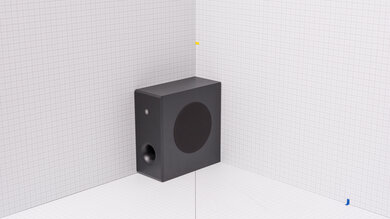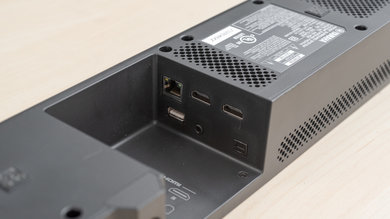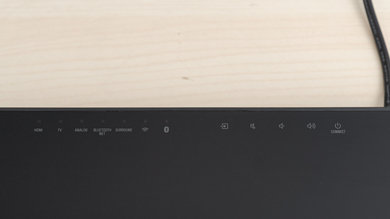The Yamaha Yamaha MusicCast Bar 400 YAS-408 is a good performing soundbar that has a great audio reproduction. It sounds very neutral and packs a decent amount of bass too. However, it lacks height channels and Atmos, which results in a less immersive listening experience. Some people might also feel that the sub-bass is lacking and missing a bit of punch. Nevertheless, the YAS-408 performs well, even at a high volume. Its virtual surround sound mode is also decent, but we suggest not using the 3D mode, as it sounds bad.
Our Verdict
Decent for mixed usage. The Yamaha YAS-408 has a great audio reproduction that is suitable for most music genres and dialogue content like podcasts and audiobooks. However, it has sub-par performance with surround channels and doesn’t support height channels, resulting in a less immersive listening experience with movies. Unfortunately, its soundstage isn’t that wide, and the bar will downmix surround content down to stereo.
-
Neutral and accurate audio reproduction.
-
Well-built design.
-
Great for voice-oriented content.
-
Lacks sub-bass.
-
Horrible virtual 3D surround sound mode.
Great for dialogue. You can use the Yamaha Bar 400 to listen to podcasts, audiobooks, or other similar content types. The sound profile is very neutral and the overall reproduction of voices is accurate. It can also get pretty loud and you can also use the Dialogue Enhancement feature to get an even better listening experience. You’ll be able to stream content from your phone wirelessly, but unfortunately, it doesn’t have an auto-volume or night mode to normalize the sound of your different types of content.
Decent for music. The Yamaha MusicCast Bar 400's audio reproduction is accurate, but some people might feel it lacks a bit of bass, especially on bass-heavy content. While its soundstage isn’t very wide, it's well-focused and doesn’t sound too diffused. There’s not much compression at a moderate volume, but when pushed at the maximum volume, you might hear a bit of pumping and compression artifacts in the bass range, especially on bass-heavy genres. On the upside, you can easily adjust the subwoofer's level separately.
Okay for movies. The Yamaha MusicCast Bar 400 has good overall audio reproduction, but it doesn’t do well with surround channels. On top of that, the soundstage isn’t that wide and it doesn’t have height channels. All of this results in a less immersive listening experience. This 2.1 setup will downmix 5.1 content and won’t sound as real as other setups, but the virtual surround mode might help a bit. On the upside, you have a few features to customize your sound a bit to your liking, although you won’t have room correction.
- 7.2 Mixed Usage
- 7.6 Dialogue/TV Shows
- 7.3 Music
- 6.8 Movies
Changelog
- Updated Dec 10, 2021: Added third-party voice assistant compatibility.
- Updated Mar 30, 2021: Converted to Test Bench 1.0.
- Updated Sep 27, 2019: Review published.
Check Price
Compared To Other Soundbars
The Yamaha YAS-408 is a decent soundbar with a great audio reproduction, especially with dialogue and stereo content. It's well-built and comes with a decent subwoofer, but some may feel it lacks sub-bass. It also has two surround modes, but we suggest never using the 3D surround as its quality is bad and it doesn't offer an immersive experience. See our recommendations for the best soundbars, the best soundbars with subwoofer, and the best Dolby Atmos soundbars.
The Yamaha YAS-408 and Yamaha YAS-209 are very similar, but the YAS-408 is ever so slightly better thanks to a better build quality and the ability to play content wirelessly via AirPlay, which the YAS-209 can't do. Sound-wise, they pretty much have the same sound signature and most people won't notice the difference.
The Sonos Beam (Gen 2) is better than the Yamaha YAS-408. The Sonos is a better built 5.0 setup that supports Dolby Atmos content. It has better soundstage, center, and surround performances, too. However, the 2.1 Yamaha has a dedicated subwoofer and can reproduce a more extended low-bass. It also gets louder with a bit less compression at max volume.
The standalone Sonos Arc is a better soundbar than the Yamaha YAS-408. The Sonos is better built, and unlike the Yamaha, it supports Dolby Atmos content and has built-in voice assistant support. It offers better soundstage, center, and surround performances and even comes with a room correction feature. However, the Yamaha reproduces a more extended low-bass, supports more wireless playback options, and has a Full HDMI In port.
The Sony HT-G700 is marginally better for mixed usage than the Yamaha YAS-408. The Sony is a 3.1 setup that supports Dolby Atmos content, unlike the Yamaha. Also, it has a discrete center channel. However, the 2.1 Yamaha has a better soundstage and less compression when you play it at max volume.
The Samsung HW-Q800A is better than the Yamaha YAS-408. The Samsung is better built, and it supports Dolby Atmos content. It has better soundstage and center performances as well as built-in voice assistant support. It even comes with a graphic EQ and presets to help you customize its sound.
The Klipsch Cinema 600 is better than the Yamaha YAS-408. The Klipsch is a 3.1 setup with a better soundstage and a discrete center channel. However, the Yamaha is better built, and it has a Full HDMI In port for high-quality passthrough, unlike the Klipsch.
The JBL Bar 9.1 is better than the Yamaha YAS-408. The JBL is a 5.1.4 setup that's better-built and comes with dedicated satellites. It has better soundstage, center, and surround performances, and it comes with more sound enhancement features. Unlike the Yamaha, it also supports Dolby Atmos content.
The Yamaha YAS-408 and Yamaha YAS-207 models are very similar. They have about the same sound signature and overall performance. However, the YAS-408 can play content wirelessly via Wi-Fi and AirPlay, which the YAS-207 can't do. It is also slightly better-built and doesn't have any fabric in its design. Overall, the YAS-408 is a better soundbar, but the price difference might not be worth it for some.
The Samsung HW-Q900A is significantly better than the Yamaha YAS-408. The Samsung is a 7.1.2 setup with better soundstage, center, and surround performances. Unlike the Yamaha, it supports Dolby Atmos content and has built-in voice assistant capabilities. It gets louder with less compression at max volume, and there are more sound enhancement features, including room correction and a graphic EQ.
The Samsung HW-Q950A is much better than the Yamaha YAS-408. The Samsung is an 11.1.4 setup that comes with discrete satellites. It has better soundstage, center, and surround performances, and it gets louder. Unlike the Yamaha, it supports Dolby Atmos content and comes with built-in voice assistant capabilities. It also has more sound enhancement features, like room correction and a graphic EQ.
The Samsung HW-Q600A is better than the Yamaha YAS-408. The Samsung is a 3.1.2 setup that's better-built and offers a better center channel performance. Unlike the Yamaha, it supports Dolby Atmos content, and it offers a graphic EQ and presets for sound customization. That said, the 2.1 Yamaha has a better surrounds performance and more wireless playback options.
The Samsung HW-Q700A is better than the Yamaha YAS-408. The Samsung is a 3.1.2 setup that's better-built, and it supports Dolby Atmos content. It also has better center and soundstage performances, and it comes with a graphic EQ for sound customization.
The Samsung HW-Q80R and the Yamaha YAS-408 are two soundbars with different setups. The Samsung is a 5.1.2 channel soundbar that has overall great performance. The Samsung has height channels, a lot of sound enhancement features like a graphic EQ, and it can get loud. It can also support Dolby Atmos content, which is great for movies. The Yamaha, on the other hand, is a 2.1 soundbar well-suited for dialogue and watching TV shows. It has a thumpy bass, and unlike the Samsung, it can support Apple AirPlay. However, the Yamaha has a terrible virtual 3D surround sound mode and you're better off using the normal surround sound mode instead.
The Yamaha YAS-408 performs better than the Sonos Playbar by itself. Without its dedicated sub, the Sonos doesn't have a great bass performance. On the other hand, it has a 3.0 speaker configuration, meaning it has a center channel for better and clearer dialogue, which the Yamaha soundbar doesn't have. The Sonos also has a noticeably larger soundstage which is immersive. It also has room correction but lacks modern inputs like HDMI ports.
Depending on your listening habits, you may prefer either the Yamaha YAS-408 or the JBL Bar 5.1 Surround. The Yamaha is a 2.1 setup with a better soundstage. It also gets louder with less compression at max volume. However, the 5.1 JBL is better built, with better surround and center performances. It comes with room correction and Chromecast built-in support, unlike the Yamaha.
The Samsung HW-Q70R is a slightly better soundbar system than the Yamaha YAS-408. It's more versatile, thanks to its 3.1.2 speaker configuration. This means it has a dedicated center channel, which makes voices and dialog easier to understand, and also has two up-firing speakers for Atmos content. On the other hand, the Samsung cuts out surround content, while the Yamaha is able to play it, but not Atmos content.
The Samsung HW-Q70T is better than the Yamaha YAS-408. The Samsung is a 3.1.2 setup that's better built. Unlike the Yamaha, it supports Dolby Atmos content. It also has a discrete center channel, as well as a graphic EQ to help you customize its sound.
The Yamaha YAS-408 is a better soundbar than the LG SL6Y. Despite only being a 2.1 soundbar, the Yamaha's center channel performance is almost the same as the LG's, even with a dedicated center channel. Other than that, the Yamaha has more inputs, Wi-Fi and Apple AirPlay support, and better bass response. On the other hand, the LG has more sound enhancement features.
The Sonos Beam is better for most uses than the Yamaha YAS-408. The Sonos is better built with built-in voice assistant support. It has better center and soundstage performances and comes with room correction. However, the Yamaha may be better suited for movies since it has a better surround performance. Also, its dedicated sub helps reproduce a more extended low-bass.
The Yamaha YAS-408 and the Samsung HW-Q60R are very similar for mixed usage, but the Yamaha is better for stereo content while the Samsung will be better for dialog thanks to its dedicated center channel. The sub of the Yamaha performs slightly better, but the Yamaha soundbar doesn't have as many sound enhancement features as the Samsung. On the other hand, you can play content wirelessly via Wi-Fi on the Yamaha, which you can't do on the Samsung.
The Sony HT-Z9F is a bit better for mixed usage than the Yamaha YAS-408. The Sony is a 3.1 setup that supports Dolby Atmos content, unlike the Yamaha. It has a better center channel performance and offers some more sound enhancement features like EQ presets. That said, some users may prefer the Yamaha. It can reproduce a slightly more extended low-bass out-of-the-box, and it has a more balanced treble range than the Sony.
The Yamaha YAS-408 is a better option than the TCL Alto 5+. It has a very neutral audio reproduction which is great with stereo content. Although it's a 2.1 system, it still has a great center performance even without a dedicated channel, making voices and dialog clear and easy to understand. It also has more connectivity options and supports DTS, which the TCL doesn't do. Overall, the Yamaha is simply an obvious choice over the TCL.
The Bose Smart Soundbar 700 is better for mixed usage than the Yamaha YAS-408. The Bose is a better-built standalone 3.0 soundbar. It has better soundstage and center channel performances. Unlike the Yamaha, it also comes with a room correction feature. However, it doesn't come with a dedicated sub like the Yamaha, so you may prefer that bar if you want more bass in your audio.
Test Results
There are no satellites in this setup.
The Yamaha YAS-408 has a great frequency response. Its low-frequency extension is decent too, which will help to recreate the deep thump, punch, and rumble of movies and bass-heavy music. Its overall sound profile is also very neutral and accurate, which is suitable for a wide variety of music genres and other content.
While listening to the YAS-408, the soundstage is decent. It doesn’t feel to be wider than the bar itself and the bar doesn’t do any tricks to try and widen it. On the upside, the focus is great and objects in the soundstage come from a pinpoint location rather than a general area.
The Yamaha Bar 400's dynamics performance is good. It can get to a good volume level that'll be suitable for large rooms and crowded environments. However, there's a small number of noticeable compression artifacts when pushing the bar to its maximum capacities. Most people won’t notice this with real-life content.
At a normal listening volume, the amount of THD is within very good limits, so it produces a clean and pure sound. However, when pushing the bar to the max volume, there’s a big jump in THD throughout the range, especially in the mid and treble ranges, which is more noticeable than in the bass range. However, not everyone will notice this.
The Yamaha YAS-408 is a 2.1 soundbar setup that doesn’t have a dedicated center speaker but still has a good overall performance. It uses the left and right speakers to create a sound in the center, which will sound more diffused and less clear compared to a discrete center. When sending a 5.1 surround sound signal, the bar down-mixes it to 2.1 which won't sound as good as a stereo signal. However, there’s a high amount of THD at max volume, so pushing the bar to its max limits isn’t recommended.
Like most 2.1 stereo soundbars, the surround performance of the Yamaha Bar 400 is sub-par. Due to the system configuration, the soundbar will downmix surround signals down to stereo, which will greatly affect the localization of objects in the soundstage. This means the result won't be very immersive and the objects are perceived to come from the front instead of from the side or behind you.
The Yamaha YAS-408 setup doesn’t have height channels and doesn’t support Atmos.
Like the YAS-207, the Yamaha YAS-408 has sub-par sound enhancement features. It's missing Room Correction, which means this soundbar may sound differently depending on your room. There's also no Auto-Volume/Night Mode, so it can't normalize the sound between types of content like a TV show and the sound level of a commercial. On the upside, it supports a dialogue enhancement feature to help you hear the dialogue more clearly, even at lower volumes. You can also separately adjust the level of the subwoofer, which is great to adjust the amount of bass the sub is producing. Although the bar has a 3D surround mode, the sound quality isn't the best when using it. You'll be better off using the normal surround mode, which doesn't sound as bad. If you like to tweak your sound even more, check out the 3.1 LG SL6Y.
Over HDMI ARC, this soundbar can playback surround sound encoded in Dolby Digital and DTS downmixed to 2.1. Dolby Digital is very common in platforms like Netflix and Blu-ray discs. DTS however, isn't so common on its own but rather as the fallback of the high-quality lossless surround format DTS-HD MA widely found on Blu-rays. Unfortunately, object-based surround sound formats, like Dolby Atmos or the lossless 5.1 PCM, aren't supported.
Thanks to the Full HDMI In port you can place the bar between an external device like a PC or a Blu-ray player and the TV. You will be able to playback surround sound due to Dolby Digital and DTS support but you can also playback lossless 5.1 PCM. However, all these will be downmixed to 2.1 limited by the bar's design. Unfortunately, it can't decode more advanced object-based sound formats like Dolby Atmos or lossless formats like Dolby TrueHD.
The YAS-408 can playback surround sound encoded both in Dolby Digital or DTS formats when connected through its optical port. Content encoded in Dolby Digital is common in Blu-ray discs or streaming platforms, while DTS is rarely available on its own, but rather as the fallback of the DTS-HD MA, widely used in Blu-rays.
Excellent wireless connectivity. You can easily connect your mobile devices to this bar using Bluetooth. You can also connect the bar to the Wi-Fi network or cast directly from your Apple devices using AirPlay, which the Yamaha YAS-209 can't do. Unfortunately, this bar doesn't support Chromecast built-in.
The Yamaha YAS-408 will passthrough the highest quality video signal. This means that if you place it between your PC and your TV using its HDMI ports, text will look crystal clear on your TV.
Update 12/10/2021: The Yamaha YAS-408 doesn't have built-in voice assistant capabilities. However, the manufacturer says that you can use a third-party Google Home or Amazon Alexa device for voice assistant support. You just have to set it up in the Google Home or Amazon Alexa app.
The Yamaha MusicCast Controller can control most of the bar's functions, but can’t completely replace the remote as you can't control functions like the subwoofer volume. On the upside, you can cast music to the bar using the preset access to some well-known apps like Pandora and Spotify.
Comments
Yamaha YAS-408: Main Discussion
Let us know why you want us to review the product here, or encourage others to vote for this product.







































